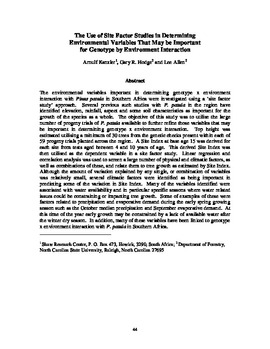| dc.contributor.author | Kanzler, A. | |
| dc.contributor.author | Hodge, G. R. | |
| dc.contributor.author | Allen, L. | |
| dc.date.accessioned | 2016-04-25T19:35:55Z | |
| dc.date.available | 2016-04-25T19:35:55Z | |
| dc.date.issued | 2003 | |
| dc.identifier | oksd_sf27_p044.pdf | |
| dc.identifier.citation | Kanzler, A., Hodge, G. R., & Allen, L. (2003). "The Use of Site Factor Studies in Determining Environmental Variables That May be Important for Genotype by Environment Interaction." In 27th Southern Forest Tree Improvement Conference, Stillwater, OK | |
| dc.identifier.uri | https://hdl.handle.net/11244/33657 | |
| dc.description.abstract | The environmental variables important in determining genotype x environment interaction with Pinus patula in Southern Africa were investigated using a �site factor study� approach. Several previous such studies with P. patula in the region have identified elevation, rainfall, aspect and some soil characteristics as important for the growth of the species as a whole. The objective of this study was to utilise the large number of progeny trials of P. patula available to further refine those variables that may be important in determining genotype x environment interaction. Top height was estimated utilising a minimum of 30 trees from the genetic checks present within each of 59 progeny trials planted across the region. A Site Index at base age 15 was derived for each site from tests aged between 4 and 10 years of age. This derived Site Index was then utilised as the dependent variable in a site factor study. Linear regression and correlation analysis was used to screen a large number of physical and climatic factors, as well as combinations of these, and relate them to tree growth as estimated by Site Index. Although the amount of variation explained by any single, or combination of variables was relatively small, several climatic factors were identified as being important in predicting some of the variation in Site Index. Many of the variables identified were associated with water availability and in particular specific seasons where water related issues could be constraining or impacting tree growth. Some of examples of these were factors related to precipitation and evaporative demand during the early spring growing season such as the October median precipitation and September evaporative demand. At this time of the year early growth may be constrained by a lack of available water after the winter dry season. In addition, many of these variables have been linked to genotype x environment interaction with P. patula in Southern Africa. | |
| dc.format | application/pdf | |
| dc.language | en_US | |
| dc.relation.ispartofseries | Sponsored publication . . . of the Southern Forest Tree Improvement Committee ; no. 49 | |
| dc.rights | This paper is made available through open access and the auspices of the fair use doctrine for scholarly, educational and research purposes while recognizing the publisher already offers a free online version. The OSU Library�s intent is to offer access and preserve publications involving its faculty contributions. Contact the Digital Resources and Discovery Services at lib-dls@okstate.edu or 405-744-9161 for the permission policy on the use, reproduction or distribution of this material. | |
| dc.source | Proceedings of the 27th Southern Forest Tree Improvement Conference, volume 27, 2003. Editor, Craig R. McKinley. | |
| dc.title | Use of Site Factor Studies in Determining Environmental Variables That May be Important for Genotype by Environment Interaction | |
| dc.type | text | |
| osu.filename | oksd_sf27_p044.pdf | |
| dc.type.genre | Conference proceedings | |
| dc.description.scopeandcontents | Papers and abstracts from the 27th Southern Forest Tree Improvement Conference held at Oklahoma State University in Stillwater, Oklahoma on June 24-27, 2003. | |
